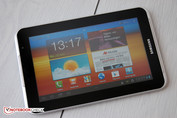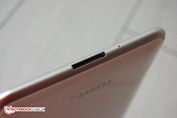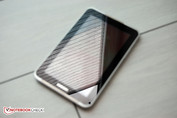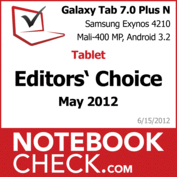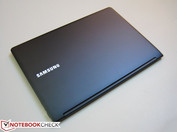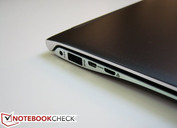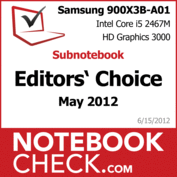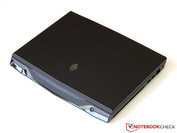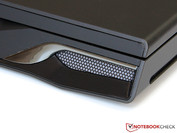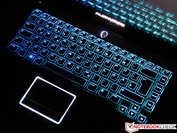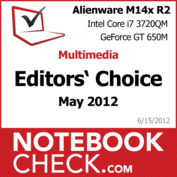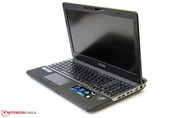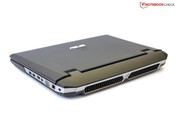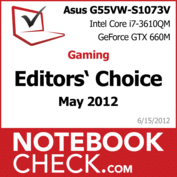Notebookcheck's Best of May 2012
The press had been silent until the end of May about the new Ivy Bridge series of dual core processors due to the embargo by Intel. The flood gates opened with a stream of articles hitting the web that sung its praises or condemned its foibles (if any). And so did we [Notebookcheck: In Review: Intel Ivy Bridge Dual-Core Processors, from the 31st of May 2012]. By the date of the publication of the article, we had only tested the new Intel quad cores, especially the Core i7-3610QM which was found in most of the laptops due to its excellent price to performance ratio.
May was dominated by Ivy quad cores combined with powerful graphics cards like the GeForce GTX 670M, GTX 660M (Kepler) and the GT 650M (Kepler). We also looked at some low performance GPUs like the GT 635M (Fermi), and the GT 620M (in the Ultrabook Asus Zenbook UX32VD). AMD was represented only by the high end Radeon HD 7970M which was surprising.
We reviewed a single netbook, the Acer Aspire One 722-C62kk (84%). The 11.6” laptop received an upgrade which featured the new AMD Radeon HD 6290 and the C60 processor. However, the performance gain was very small. Furthermore, the spongy keyboard and the reflective display with weak contrast were some of the disappointments we were faced with. We would not consider the Aspire One 722 to be a big player in a dying breed.
We also reviewed two smart phones, the HTC One S with dual core processor and the HTC One X with the quad core Tegra 3. Although they appear different, they achieved the same rating. The AMOLED and SLCD2 IPS displays feature excellent contrasts and very good screen brightness. To summarize, the cheaper HTC One S will be the better solution for most users. Both devices have decent haptic feedback, build quality and use the same Android 4.0.3 Ice Cream Sandwich OS version.
Tablet/MID
Contenders:
Samsung Galaxy Tab 7.0 Plus N 83%
ODYS LOOX 78%
Besides two low cost tablets from Archos and Odys, we reviewed the outstanding Samsung Galaxy Tab 7.0 Plus N. Although Samsung's 7” tablet can easily outperform the weak competition, we did discover a number of weaknesses. The faint and very noisy front and rear cameras were some noticeable anomalies. The PLS display has decent viewing angles, but we already had a lot of brighter tablets in for review. The battery life of six hours is passable but not good enough for a tablet. Nevertheless, we like the Galaxy Tab 7.0 much better than the Archos and the Odys. However, the customer has to spend EUR 350 (~$440, street price, June 2012) for the top model with a 3G module.
Below EUR 200 (~$250), we have tablets like the Archos Arnova 10b G2 which try to attract customers with low pricing. Despite outdated Android 2.3, tough navigation, a coarse 1024x600 pixel resolution and a bad camera, the reviewer believes that the Arnova suffices as cheap entry-level tablet. It features a stable case, a contrast-rich display and a battery life of five hours. Unfortunately the case is susceptible to scratching and the display brightness is less. Therefore, it is not possible to surf the Internet under the sun.
Some customers might think to look at the ODYS LOOX for under EUR 100 (~$125). It would be easy to make up our minds on a cheap model and live with a few compromises anyway. A Rockchip Single Core and Android 2.3 are standard. The bulky 7 inch case is very stable and features many ports. The pictures of the webcam (front only) look blurred and the resistive touchscreen responds best when used with the provided stylus (responses to finger input is very bad). However, the low brightness of the display, which is hardly legible in natural light, turns out to be a major drawback.
Tablet/MID of May 2012: Samsung Galaxy Tab 7.0 Plus N
The choice couldn’t have been easier. The compact 7-incher is stable yet light. In terms of colors, resolution and viewing angles its display easily outperforms the ones on the Archos and the Odys.
What we like
The compact dimensions and the low weight. Being able to make telephone calls on it definitely increases its value. Why don't all tablet makers include this feature?
What we would like to see
Useful cameras, a brighter screen and a little more battery life.
What surprises us
There are very few really good tablets with this size. Thanks, Samsung.
The competition
In this size category, competition is lacking. Hence, the Samsung Galaxy Tab 7.0 Plus N mostly has to duel it out with larger tablets like the Acer Iconia Tab A200, Motorola Xoom 2 MZ616, Medion Lifetab P9516 32GB+3G and the Apple iPad 3rd Gen. 2012 4G.
Subnotebook
Contenders:
Asus UX32VD Ultrabook 87%
Sony Vaio SVT1311M1ES Ultrabook 86%
Sony Vaio VPC-SA3X9E/XI 85%
Our US editor grabbed Samsung's elite Series 9 900X3B-A01. The 13.3” and the 15.6” 900X4B models supplement the successful 11.6” 900X1B. Weighing a meager 1.16kg (~2.56lb.) and achieving a passable battery life of five hours, the 13.3-incher is nearly as mobile as the 11.6” model. Samsung has to be commended for the excellent workmanship as its predecessor, and the improved display with PLS technology. Something new is that the hardware components are easily accessible. Whoever appreciates a very light subnotebook, ideal for outdoor usage because of its matte, extremely bright and high contrast display should take the Samsung 900X3B into consideration.
The Zenbook from Asus is close behind the 900X3B. It was the first time we reviewed the 13.3-inch UX32VD model with Ivy Bridge i5-3317U. It features a dedicated GeForce GT 620M graphics, which is rather unusual in the Ultrabook range. The display is a stunner- Full HD, matte, 355 cd/m2 brightness, a 1000:1 contrast ratio, and wide viewing angles due to IPS technology. Instead of the popular aluminum unibody, Asus now uses the conventional and cheap manufacturing process which includes a shell construction made from aluminum and a base unit frame made form an aluminum-plastic composite. Unfortunately Asus does not include an SSD, but an SSD cache and a mechanical HDD. But, the absence of the SSD and unibody construction lowers the price (EUR 999 or about US$1250).
Continuing with the Ultrabook trend, we also had a look at the Sony Vaio SVT1311M1ES (EUR 799 or about US$1000). We call it a Hybrid book, because the pre-production model featured a 32 GB SSD cache and a 500 GB HDD. It boots swiftly and launches programs almost instantaneously. Weighing just 1.6kg (~3.5lb.), the 13.3” laptop is heavier than the Samsung Series 9. However, the battery is not responsible for the additional weight: The battery life does not exceed four hours. Its biggest disadvantage is the dark, reflective display with dull colors and a run of the mill 1366x768 resolution. So, it is hardly possible to use the display in bright sunlight. We are curious whether the production model will also have these disadvantages (review will soon follow).
The Sony Vaio VPC-SA3X9E/XI is much more expensive than the Ultrabook, but is a full-fledged subnotebook (carrying a Core i7 Dual Core) with lot more connectivity options including a docking port. Unfortunately the display does not match the price of EUR 1800 (~$2250) which has moderate brightness, poor contrast, and narrow viewing angles. Apart from the 1600 x 900 resolution, the TFT screen is as weak as the one in the Ultrabook. Therefore, the SA3 does not receive a "Very Good" rating from us despite excellent build quality and input devices and excellent performance.
Although Schenker’s XMG A102 (Clevo W110ER) is small, it has the performance of larger gaming notebooks. It is surprising that an 11.6” chassis houses a GeForce GT 650M and an Intel Core i7-3612QM. Furthermore, it is not heavy at just 1.74 kg (~2.84lb.). Even if it cannot achieve a "Very Good" rating from us, the A102 does not have many serious weaknesses except for the low contrast display. Considering the performance, the temperature and system noise are acceptable.
Subnotebook of May 2012: Samsung 900X3B-A01
The advantages outweigh the disadvantages which includes the higher temperature profile of the case. But, other ultrabooks with comparable processors usually suffer from high temperatures and don’t have much gaming performance. The low system noise due to the quiet fans of the 13.3” laptop is surprising.
What we like
When taken as a whole, the slim looks, low noise, bright display and excellent build quality of the 900X3B are simply unmatched.
What we'd like to see
An Ivy Bridge update could potentially boost performance, graphics and battery life significantly. Absence of a docking port, GPS and WWAN features with better system cooling are some of our complaints.
What surprises us
The 900X3B is even slimmer than its older brother, yet feels just as durable and with a slight CPU upgrade. The impressive display is leaps and bounds ahead of the first generation Series 9.
The competition
Asus UX31 ZenBook, Acer Aspire S3, Toshiba Portege Z830, Dell XPS 13, Apple MacBook Air 13, HP Envy 15, Lenovo X1, Lenovo U400, Sony Vaio VPC-Z23N9E/B, Acer Aspire Timeline Ultra M3, HP Folio 13
Multimedia
Contenders:
Sony Vaio VPC-EH3C0E/W 79%
In May we reviewed a vast number of multimedia notebooks - 8 models. They ranged from serious gaming laptops (Alienware M14x R2) to cheap entertainment computers (Vaio VPC-EJ3D1E/W). The Alienware M14x R2 (EUR 1650) achieved the best rating. Its key features are a high contrast WXGA++ display, decent GeForce GT 650M performance and excellent system performance as the 14-incher came with a Core i7-3720QM and an mSATA SSD. Furthermore, the Dell has excellent build quality and looked solid. Unfortunately it gets hotter and louder than Schenker's XMG A102 (11.6” gaming laptop).
The Asus N55SL-S1016V is a 15.6” laptop with gaming ambitions (GeForce GT 635M), a full HD display, and very low emissions. The display has a decent contrast and is sufficiently bright. Therefore, the N55SL can also be used outdoors. Perfect? Not quite, as its keyboard is spongy and its connectivity meager.
The Vaio VPC-SE2M9E/B features fast Sandy Bridge hardware inside a magnesium alloy case. The 15.6”laptop weighs only 2 kg and features a bright, matte display. Unfortunately the short battery life of around three hours does not match its mobility ambitions (comes with a 3G module). The IPS display with wide viewing angles and full HD resolution is perfect for a business laptop. The only real disadvantage is the very sensitive fan control. Even while surfing the Internet, the fan abruptly speeds up quickly, becoming noisy [32 dB (A)], just to fall quiet a few seconds later.
Samsung's Series 5 550P7C-S02DE features new Ivy Bridge hardware, a powerful GeForce GT 650M and a matte TFT with 1600x900 resolution. Unfortunately contrast and brightness of the 17.3 inch display are too low for outdoor usage. But gaming performance, low system noise and good system performance are some standout features, even if it does not come with an SSD. It turns out that high temperatures of the case is a weak point and also causes CPU throttling under load. However, the sound with distinctive high and mid tones and the subwoofer performance are excellent.
We also reviewed a wannabe premium multimedia laptop, the Acer Aspire V3-771G multimedia laptop. Due to the GeForce GT 650M, Core i7-3610QM and SSD (+HDD) its performance (96%) including gaming is decent without a doubt. Temperature and system noise remain within limits, but unfortunately the reflective display has poor viewing angles and dull colors. Apart from performance, a EUR 1300 (~$1600) device should feature a better TN display and build quality.
Schenker's XMG A502 (Clevo W150ER) was upgraded to include the latest generation of hardware. The GeForce GT 555M was replaced by the GeForce GT 650M, the Sandy Bridge CPU by a Core i7-3610QM. However, the simple plastic look of it 15.6” predecessor remained. It also includes the much criticized ”sandpaper surface” of the touchpad. A highlight is the very bright, matte and high contrast full HD display, which allows for working outside. Because of its high emissions, its short battery life and the touchpad the laptop only achieves a "Good" rating.
A Vaio for a small budget? This could be the Vaio VPC-EH3C0E/W. As it features a Pentium processor and no dedicated GPU, it is not suitable for gaming. Decent input devices, low noise and temperature emissions would allow it to be useful in an office environment. But, the reflective 15.5 inch display with narrow viewing angles is inadequate.
The Sony Vaio VPC-EJ3D1E/W looks like a white giant (17.3 inch). The customer gets a weak standard display for about EUR 800 (~$970). However, the input devices are excellent and so are the low emissions.
Multimedia notebook of May 2012: Alienware M14x R2
According to the ratings, the Alienware M14x R2 (86%) wins the title and prevails over seven competitors. Gamers will appreciate the near flawless build quality and the high gaming performance.
What we like
The near perfect workmanship as well as the powerful combination of the GeForce GT 650M and Core i7-3720QM made us pretty happy.
What we would like to see
A non-reflective display and a better cooling system would help the M14x out. Beyond that, there was little room for criticism.
What surprises us
The ridiculous prices that Dell is charging to upgrade certain components. Recommendation is to make the upgrades aftermarket.
The competition
Comparable 14" notebooks are currently not available, so the M14x primarily compete with 15" notebooks like the Schenker XMG A502, Samsung 550P5C and the Asus N56. Whoever would like an extremely compact gamer should take a closer look at the Schenker XMG A102.
Gaming/DTR
Contenders:
Alienware M17x R4 88%
Asus G55VW-S1073V 88%
MSI GT60-i789W7H 84%
One M73-2O 81%
In the category of genuine gamers and workstations, the Alienware M17x-R4 with the AMD Radeon HD 7970M outperformed every other competitor. Revision 4 (R4) of Dell's flagship for wealthy gamers features an Intel Ivy Bridge quad core CPU. It meets our high expectations on build quality, performance, connectivity, sound and image quality. The case remains mostly unaltered as it was already close to perfect before. But the laptop does fall short when it comes to noise levels; a score of 77% for system noise is disappointing. This is deceptive. The laptop is surprisingly quiet while idle. However, the M17x exceeds the disruptive 50 dB (A) level under extreme load.
The Asus G55VW-S1073V complements the high end Asus G75V (17.3” screen size), with a 15.6-inch form factor and smaller and slightly cheaper hardware. The GeForce GTX 660M does not have problems with most of the games, even in native full HD and high details. Throttling is not an issue for the CPU. So, users can enjoy the fast i7-3610QM and the Seagate Momentus 7200 rpm HDD without restrictions. However, people looking for extreme performance would like to see an SSD. But, the cheap price and the large storage capacity of HDD compensate for the absence of the SSD.
The MSI GT60-i789W7H is a 15.6”gaming notebook. The GeForce GTX 670M and the Core i7-3610QM provide excellent gaming performance even without SSD. The stability of the case is very good, but, due to its high weight and bulky size, you would not want to carry it around. However, you will appreciate the matte, high contrast and bright display.
The vendor One, took Clevo's barebone and packed an Ivy quad core, 8 GB RAM, an OCZ Nocti SSD (120 GB), a 500 GB hard drive and a full HD display into it for EUR 1100 (~$1400). The screen is a matte display and has a high contrast. The laptop achieves an unequaled 100% in system performance! What else could customers desire for such a relatively low price? However, due to several flaws, the rating is lower than expected. The build quality of the case is bad, the keyboard is spongy, the connectivity meager and temperature as well as system noise are high. This is like a motorbike equipped with a fast engine and a flimsy chassis that comes apart if you push it.
Gaming notebook of May 2012: Asus G55VW-S1073V
Because of its lower price, we elect the Asus G55VW. Although the Geforce GTX 660M is much slower than a Radeon HD 7970M, the Asus G55VW-S1073V has the better price to performance ratio than the EUR 2000 (~$2500) Alienware M17x R4.
What we like
The new and improved design. The fact that the 15.6-inch Republic of Gamers laptop is still the most silent gaming laptop on the market. Great performance.
What we'd like to see
A lower weight, perhaps by using lighter materials. The large frame around the display feels outdated.
What surprises us
It is surprising that Asus hasn't activated the switchable graphics feature Optimus.
The competition
The 15-inch Clevo P150EM is configurable with much faster GPUs, but is not nearly as cool and quiet as the G55VW. Another alternative with approximately the same weight is the 17.3” MSI GT70.




